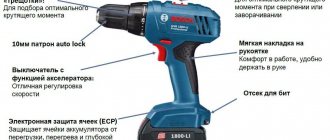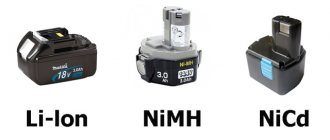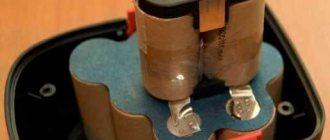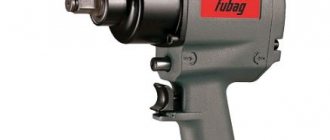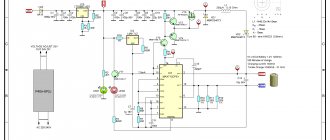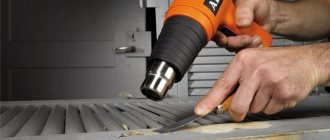A screwdriver is essentially an electrical substitute for a screwdriver. It performs the same functions as its younger “brother”, only it makes the process of tightening/unscrewing screws and bolts much faster. This tool is especially effective if there are dozens or even hundreds of screws. The device can do more than just turn screws. By installing a special drill, you can use a screwdriver to make holes in wood, plastic and thin metal. More powerful devices even take brick and concrete. In general, the tool is indispensable in everyday life and for repairs.
According to owner reviews, cordless screwdrivers are the most convenient for use. Is this really so and how to choose a cordless screwdriver, the article will tell you, based on the advice of experienced craftsmen.
Types of batteries by type of materials used
Which batteries are best for a screwdriver are usually indicated in the instructions for this tool. The battery type is indicated in Latin letters. Most often, high-current 18650 batteries are used for screwdrivers. However, there are other options.
Such devices are produced by a variety of brands. The most famous include Bosch (Bosch), Hitachi, Zubr, Interskol, Metabo. It is also possible to order a battery on Aliexpress in China. However, it is better to give preference to trusted manufacturers.
Nickel-cadmium
This type of battery appeared in the middle of the last century. They use nickel oxide hydrate as a cathode, which complements graphite powder. An electrolyte is used to move the ions. Potassium hydroxide is used in its role. It also contains an anode made from cadmium oxide hydrate.
Nickel metal hydride
This material is most often used in AA batteries. It was invented in the seventies of the last century. Nickel oxide and nickel-lanthanum are used as the main elements for accumulating and transferring charge. The first component is the cathode, the second is the anode. Potassium hydroxide is responsible for the movement of ions.
Lithium-ion batteries
These are relatively new batteries that were invented only in 1991. They are often used by Japanese companies. The cathode and anode are made of foil. A separator is installed between these elements, which has holes. A valve is used to relieve internal pressure.
Lithium polymer battery
This is a modern material that is based on the use of lithium-ion technology. Therefore, it is almost never used for the production of electrical equipment. Instead of a standard electrolyte, such devices use a gel polymer. Thanks to this, manufacturers were able to significantly increase capacity. In addition, they can give the battery any shape.
Note! If you need to buy an affordable and long-lasting battery, a nickel-cadmium model is suitable. If you need a high volume of capacitive charge, you should use lithium-based products.
There are different types of battery materials
Torque
This parameter is measured in newton meters (Nm). It shows how much force the tool is capable of: how thick the screw is and how deep the device can screw. Most screwdrivers have a torque in the range of 10-50 Nm, although it can be higher.
There are different types of torque (soft, hard, maximum, long-lasting), and manufacturers do not always indicate a specific one, so you can only focus on this parameter in conjunction with other characteristics.
Battery types
Today there are quite a few effective batteries that can be used in screwdrivers. However, they all have certain pros and cons. So, how to choose a battery for a screwdriver?
Nickel-cadmium and nickel-metal hydride batteries
Many people are interested in which battery is better, li-ion or ni-cd for a screwdriver. To choose, you need to understand their pros and cons.
Nickel-cadmium products belong to the alkaline category. They provide stable power and do not heat up.
The main disadvantage of the products is the high toxicity of cadmium. In addition, they have a pronounced memory effect. Therefore, the products have to be charged after being completely discharged. The advantages of the models include stable operation even in cold weather, fast charging, and light weight.
Nickel metal hydride (Ni-MH) products appeared a little later. They do not involve the use of toxic cadmium. At the same time, the main disadvantages of the products include heating of the components, a small temperature range, and loss of capacity upon complete discharge.
Lithium-ion batteries and their benefits
These batteries are considered a new development. They are not alkaline elements and are rapidly displacing Ni-Cd and Ni-MH from the market.
The advantages of such products include the following:
- no memory effect;
- high capacity;
- low self-discharge parameters;
- fast charging;
- high fire safety indicators;
- high energy intensity.
At the same time, the disadvantages of such products include high price, the need to ensure certain storage conditions, and limited service life. You also have to have special chargers depending on the type of battery.
Lithium-ion batteries have many advantages
The best screwdriver manufacturers
There are many manufacturers of screwdrivers. But among them there are several companies whose products can be trusted almost without reservation.
Bosch is a well-known German brand under which household appliances, electronics and power tools have been produced for almost a century and a half. Known for its high-quality and reliable products, albeit quite expensive. Bosch tools are differentiated by color: green housing means a home model, blue – a professional one.
Makita is a popular Japanese company. Their products are distinguished by ergonomic shapes and compact sizes - this applies to both professional screwdrivers and simpler home models.
Dewalt is a manufacturer from the USA. Screwdrivers under this brand are distinguished by high power, reliability and safety in use. The company does not skimp on LED lighting, rubberized handles and self-clamping chucks, even in its not the most expensive models.
Black&Decker are another American. Among manufacturers of high-quality power tools, this company produces probably the most inexpensive products. That, however, does not prevent them from making decent instruments.
Huyndai , a specialized division of the Japanese auto giant, entered the market relatively recently, but has already established itself as a first-class product. It produces both home and professional models: under the Home and Expert brands, respectively.
Interskol is a Russian manufacturer that is in no way inferior to foreign competitors in terms of the quality, convenience and functionality of its tools. Prices, in turn, are very affordable.
Zubr is another company from Russia whose screwdrivers have a good price-quality ratio. Home appliances are produced under the “Master” brand, “Pro” tools are intended for professional use, and “Expert” tools are intended for specialized, narrow-profile work.
Comparison of batteries used for screwdrivers
How to choose a battery for a screwdriver? To do this, you need to take into account a number of important parameters.
Number of charge and discharge cycles
In devices with Ni-Cd batteries, this parameter reaches 1000 cycles. That is why they occupy a leading position in this indicator. In this case, Li-Ion batteries can be charged and discharged 600 times, after which they need to be replaced.
Fast charging ability
For large-scale work, craftsmen often use 2 batteries. In such a situation, charging speed matters. For nickel-cadmium and nickel-metal hydride batteries, this parameter is 4-8 hours. In this case, lithium-ion batteries can be charged from half an hour to 2 hours.
For reference! Popular European and Japanese manufacturers add a second battery to the device. In this case, the user can work almost without interruption.
Price
Nickel-cadmium batteries have the most affordable price. In second place are nickel-metal hydride batteries. Li-Ion products are considered the most expensive. Sometimes their price is half the cost of the screwdriver itself.
Response to tool operation at full power
If you need to make a hole in a hard surface, the full power of the screwdriver is required. In such a situation, it begins to actively consume charge. Ni-Cd and Ni-Mh are considered the most powerful. If you need maximum energy output, you should give preference to them.
Charge level memory effect
If the battery is not completely discharged and is put on charge, the remaining indicators are perceived by it as 0. This condition is called the memory effect. It is typical for all batteries that contain nickel. However, lithium-ion models do not have this drawback.
Self-discharge
Sometimes there is a situation in which a screwdriver was not used, and then suddenly needed. In this case, it may turn out that the battery has discharged itself and needs to be charged. This option is considered not very convenient. This situation is typical for nickel-cadmium and nickel-metal hydride batteries. In the first case, the self-discharge rate is 10%, in the second - 7-10% per month. For lithium-ion batteries it does not exceed 3-5%.
Batteries need to be charged on time
Dimensions
The batteries are attached to the screwdriver handle. Their size determines the weight of the power tool and the comfort of its use. This is relevant when working for a long time. Nickel-based batteries are considered the heaviest.
Note! Lithium-ion devices are smaller in size. They are made in the form of a clip, which takes up space in the tool handle and has no extension.
Working in the cold
Most often, this power tool is used inside buildings. But from time to time it has to be used in the fresh air or in rooms without heating. In this case, you need to know that lithium-ion models do not withstand negative temperatures well. They quickly discharge or fail completely.
Therefore, in such conditions it is recommended to give preference to batteries with nickel. They hold a charge well and can function even at temperatures of -20 degrees.
Attitude towards full discharge
This parameter affects the duration of use of the device. Lithium-ion batteries must not be completely discharged. The ideal storage option is considered to be 40% charge. Nickel batteries can be used until the power tool stops rotating completely.
Estimated service life
The duration of use is affected by the frequency and correctness of use. Lithium-ion batteries last the longest.
What types of screwdrivers are there?
Ordinary screwdriver
An average power tool in all respects, designed for tightening fasteners and, to a lesser extent, for drilling. It is usually equipped with a jaw chuck in which bits or drills can be fixed. Screwdrivers can be powered by mains or batteries and have different characteristics, but more on that below.
Electric screwdriver
The simplest and least powerful type of screwdriver. It is battery powered and has minimal functionality. As a rule, electric screwdrivers do not have a pulse mode, a speed switch, or even a jaw chuck - the bits are secured in a ¼” hex socket. However, there are adapters for other attachments.
Electric impact wrench
The ultimate purpose of this device is to replace a wrench in the same way that a screwdriver replaces a regular screwdriver. Usually the seat here is a tetrahedral rod designed for installing nut heads. Typically, impact wrenches can operate in a pulse mode, which allows you to unscrew even rusted and stuck bolts and nuts.
Drill/driver
The most powerful, heaviest, complex and, as a rule, expensive device in its class. This tool is capable of not only tightening a couple of screws, but also drilling concrete or, say, brick. Drill drivers operate at multiple speeds so you can choose between fastener handling and drilling modes. They are equipped with jaw chucks, a speed controller, reverse and impact mechanism.
A drill/driver with a hammer drill function can not only rotate the drill, but also deliver blows at the same time. This makes it much easier to make holes in hard materials, but such tools are also more expensive.
What to look for when buying a cordless screwdriver
To purchase a quality device, it is recommended to take into account a number of important parameters.
What does battery capacity mean?
This indicator is designated by numbers 1-7 and is estimated in amperes. Since the tool requires 1-5A per hour, it can be used for 2-8 hours.
When purchasing, you need to consider the capacity
What does battery voltage mean?
The maximum voltage setting for screwdrivers is 36 V. They are suitable for working on durable materials. Indicators of 3-10 V are typical for low-power devices. They can only be used for small fasteners or soft materials.
Varieties
- It must be said right away that a drill-driver and a screwdriver are one and the same thing. Almost all modern screwdrivers, in addition to their main function, can also drill holes. The main difference between a conventional electric drill and a screwdriver is that it has the ability to adjust the torque. This allows you to screw both small screws into plastic and long ones into wood, without the risk of tearing off the mounting hole on the head or damaging the material. Another difference is battery power.
- Another similar tool, which due to inexperience can be confused with a screwdriver, is a cordless screwdriver. It has compact dimensions and low power, so it is only suitable for working with small fasteners (for example, disassembling/assembling household appliances).
Cordless screwdriver
- Impact wrenches are very similar in appearance to screwdrivers, but they also belong to a separate type of tool.
Impact wrench
- Drywall screwdrivers are a highly specialized type of tool; they have a depth limiter and their power is designed only for the intended purpose.
Drywall screwdriver
Are there plans to create magnesium batteries and introduce them into everyday life?
At the end of the 2010s. American scientists have created a magnesium-chromium battery that eliminates the possibility of overheating when recharging or in hot weather. It also differed from Li-Ion and Ni-Cd in its environmental friendliness and extended service life.
In 2011, it was also planned to create a magnesium-sulfur battery with a higher specific energy intensity than its predecessors - over 4000 Wh/l.
At the moment, magnesium batteries are not widely used and are not yet used for charging screwdrivers.
DIY screwdriver power supply repair
In fact, all repairs at home consist of replacing containers with new ones. And even then, only if there is a donor - the same battery. Any battery for a screwdriver is a set of cans or containers with chemical elements inside. Therefore, the diagnosis of failed devices begins with checking these containers.
Diagnostics
The capacities are connected in series in the battery, that is, the failure of one will affect the operation of the entire device. To diagnose, you need to conduct a small experiment, which will require a multitester.
This is what an assembly of elements in one screwdriver battery might look like
First, you need to fully charge the battery. Then take it apart and measure the voltage on each bank. The run-up should be within 1.2-1.4 V for nickel-cadmium and 3.6-3.8 V for lithium-ion. For convenience, you can mark jars that fall outside the specified limits. Then the battery must be reassembled and discharged until there is a clear loss of power. After this, we again disassemble and measure the voltage.
You will need a soldering iron for assembly.
Containers with the greatest difference between elements must be replaced. You can take new banks either from a donor - another old or unnecessary battery, or order from one of the online stores on the network. Naturally, the dimensions and characteristics must completely coincide with the “recipient”.
Recovery
Only nickel-cadmium battery containers can be restored. And even then, this operation will not make the jar new. It will only delay failure.
The battery can be restored in two ways: by compression or compaction, or by applying a voltage and current much higher than the rated one. The first method is suitable when the electrolyte is still present, but the volume is lost. The second neutralizes the effect of the memory effect and returns capacity. A third option is also used, when electrolyte is manually added to the container. But, as mentioned above, all restoration methods are a temporary measure that only slightly prolongs the “agony” of the battery. It is better to completely replace the element with a new one. Fortunately, their prices are not very high now.
Useful tips for caring for batteries
For stable and long-term battery operation, several recommendations should be followed:
- Charge and fully discharge the battery 1 or more times before heavy use. This is important for the battery to reach its maximum power and capacity.
- It is recommended to charge the battery at temperatures from 10 to 40 degrees Celsius. If the battery gets very hot, leave it to cool down. There are chargers equipped with a battery protection system from overheating.
- Do not store the battery in the tool.
- During long-term non-use ( 6 months or more ), it is recommended to charge the battery from time to time.
Storage conditions for different types of batteries:
- Ni-Cd - at final discharge;
- Ni-Mh - partially discharged;
- Li-Ion - fully charged.
